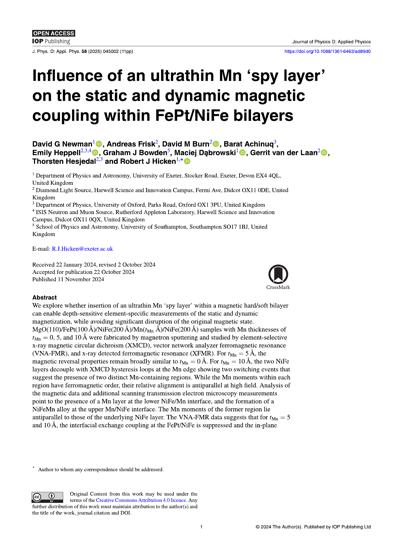
Influence of an ultrathin Mn 'spy layer' on the static and dynamic magnetic coupling within FePt/NiFe bilayers
D. G. Newman, A. Frisk, D. M. Burn, B. Achinuq, E. Heppell, G. J. Bowden, M. Dabrowski, G. van der Laan, T. Hesjedal and R. J. Hicken
J. Phys. D: Appl. Phys.. 58, 045002 (2025)
DOI: 10.1107/S160057752400119X
We explore whether insertion of an ultrathin Mn 'spy layer' within a magnetic hard/soft bilayer can enable depth-sensitive element-specific measurements of the static and dynamic magnetization, while avoiding significant disruption of the original magnetic state. MgO(110)/FePt(100 A)/NiFe(200 A)/Mn(tMn A)/NiFe(200 A) samples with Mn thicknesses of tMn = 0, 5, and 10 A were fabricated by magnetron sputtering and studied by element-selective x-ray magnetic circular dichroism (XMCD), vector network analyzer ferromagnetic resonance (VNA-FMR), and x-ray detected ferromagnetic resonance (XFMR). For tMn = 5 A, the magnetic reversal properties remain broadly similar to tMn = 0 A. For tMn = 10 A, the two NiFe layers decouple with XMCD hysteresis loops at the Mn edge showing two switching events that suggest the presence of two distinct Mn-containing regions. While the Mn moments within each region have ferromagnetic order, their relative alignment is antiparallel at high field. Analysis of the magnetic data and additional scanning transmission electron microscopy measurements point to the presence of a Mn layer at the lower NiFe/Mn interface, and the formation of a NiFeMn alloy at the upper Mn/NiFe interface. The Mn moments of the former region lie antiparallel to those of the underlying NiFe layer. The VNA-FMR data suggests that for tMn = 5 and 10 A, the interfacial exchange coupling at the FePt/NiFe is suppressed and the in-plane